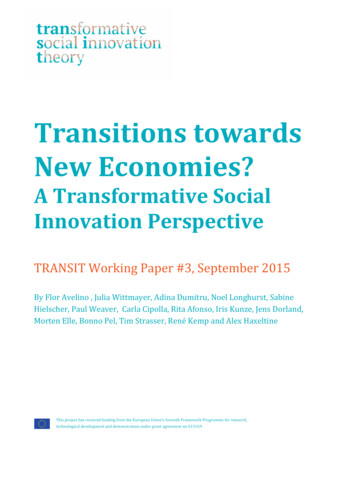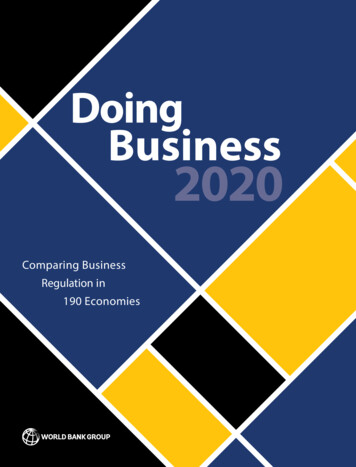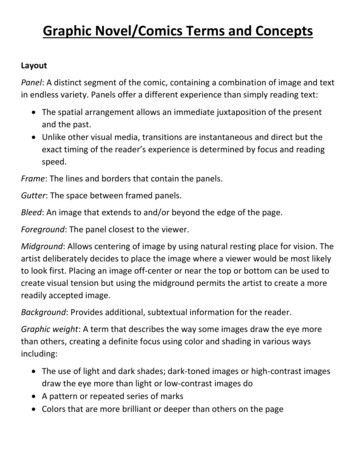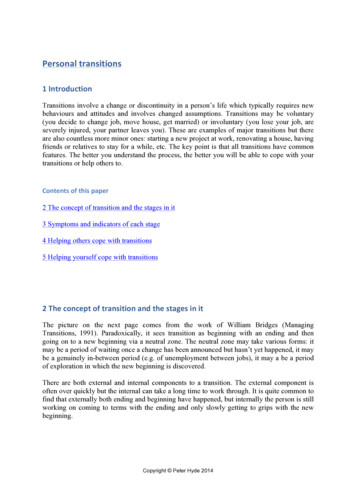
Transcription
Transitions towardsNew Economies?A Transformative SocialInnovation PerspectiveTRANSIT Working Paper #3, September 2015By Flor Avelino , Julia Wittmayer, Adina Dumitru, Noel Longhurst, SabineHielscher, Paul Weaver, Carla Cipolla, Rita Afonso, Iris Kunze, Jens Dorland,Morten Elle, Bonno Pel, Tim Strasser, René Kemp and Alex HaxeltineThis project has received funding from the European Union’s Seventh Framework Programme for research,technological development and demonstration under grant agreement no 613169
About TRANSIT:TRANSIT is an international research project that develops a theory of Transformative SocialInnovation that is useful to both research and practice. It is co-funded by the EuropeanCommission and runs for four years, from 2014 until 2017. The TRANSIT consortium consists of12 partners across Europe and Latin America. For more information, please visit our ut the TRANSIT working papers series:The TRANSIT working paper series aims to accelerate the public availability of researchundertaken by TRANSIT researchers. It presents (intermediate) research results that in whole orpart are suitable for submission to a scientific journal or book. It also considers those articles,which are appropriate for submission to (scientific) conferences, workshops or symposia. Ourintention is to provide early access to TRANSIT king-papersAbout this TRANSIT working paper:This paper has been presented at the 6th International Sustainability Transitions (IST)Conference, Sustainability Transitions and Wider Transformative Change Historical Roots andFuture Pathways, 25th – 28th August 2015, Brighton, University of Sussex Campus (Falmer).Suggested citation:Flor Avelino , Julia Wittmayer, Adina Dumitru, Noel Longhurst, Sabine Hielscher, Paul Weaver,Carla Cipolla, Rita Afonso, Iris Kunze, Jens Dorland, Morten Elle, Bonno Pel, Tim Strasser, RenéKemp, Alex Haxeltine (2015), “Transitions towards ‘New Economies’? A Transformative SocialInnovation Perspective”, TRANSIT working paper #3, September 2015. Available online tive-social-innovation-perspectiveDate:October 2015Authors:By Flor Avelino, Julia Wittmayer, Adina Dumitru, Noel Longhurst, Sabine Hielscher,Paul Weaver, Carla Cipolla, Rita Afonso, Iris Kunze, Jens Dorland, Morten Elle,Bonno Pel, Tim Strasser, René Kemp and Alex HaxeltineContact:Flor Avelino e-mail: avelino@drift.eur.nlOnline ative-social-innovation-perspectivei
Transitions towards ‘New Economies’? A Transformative Social InnovationPerspectiveAuthors: Flor Avelino, Julia Wittmayer, Adina Dumitru, Noel Longhurst, Sabine Hielscher, PaulWeaver, Carla Cipolla, Rita Afonso, Iris Kunze, Jens Dorland, Morten Elle, Bonno Pel, Tim Strasser,René Kemp, Alex HaxeltineAbstractThere are numerous social innovation networks and initiatives worldwide with the ambition tocontribute to transformative change towards more sustainable, resilient and just societies. Manyof these have a specific vision on the economy and relate to alternative visions of a ‘New Economy’.This paper highlights four prominent strands of new economy thinking in state-of-the-artdiscussions: degrowth, collaborative economy, solidarity economy, and social entrepreneurship.Taking a perspective of transformative social innovation, the paper draws on case studies of 12social innovation initiatives to analyse how these relate to new economies and to transitionstoward new economic arrangements. The 12 cases are analysed in terms of a) how they relate tonarratives of change on new economies, b) how they renew social relations, and c) how their neweconomy arrangements hold potential to challenge established institutional constellations in theexisting economy.KeywordsSocial innovation, transformative change, new economies, sustainability transitionsResearch Highlights Approaches the new economy from the perspective of transformative social innovation,with a focus on changing social relations. Distinguishes 4 meta-narratives on new economy: (1) degrowth & localisation, (2)collaborative economy, (3) solidarity economy, (4) social entrepreneurship & socialeconomy. Empirically explores how 12 social innovation initiatives relate and contribute to neweconomies by renewing and challenging social relations. Explores the renewal of social relations at the level of individual actors as well as at thelevel of institutional constellations.1
1. IntroductionThe emergence of persistent sustainability problems in such sectors as energy, water and foodhas led to renewed interest in the ways in which society can combine economic and socialdevelopment with the reduction of its pressure on the environment. Transitions research hasemerged in recent years as an exciting new approach to sustainable development that seeks tocontribute by researching transformative change at the systems level, conceptualized as‘sustainability transitions’ (Grin et al. 2010). This new field of sustainability transitions researchhas emphasised how change involves more than technology alone. Rather, technical changes needto be seen in their institutional and social context, generating the notion of ‘socio-technicalsystems’, which are often stable and path-dependent, and therefore difficult to change. Undercertain conditions and over time, the relationships within socio-technical systems can becomereconfigured and replaced in a process that may be called a system innovation or a transition.There is an increasing attention for the relation between sustainability transitions and economicdevelopments, including, for instance, the economic crisis (Van den Bergh 2013) and greengrowth (Geels 2013, van der Ploeg 2013).Meanwhile a parallel development, arising to a significant extent in a civil society context, hasinvolved critiques of current economic and institutional arrangements and the emergence ofinitiatives aiming to promote alternative ‘new economic’ arrangements (such as e.g.complementary currencies, Seyfgang & Longhurst 2013). These initiatives are arguably providingexperiments, learning and impetus for nascent sustainability transitions. In fact there now existsa vast, diverse and growing number of networks and initiatives across the world, many of whichhave the explicit ambition to contribute to transformative change towards more sustainable,resilient and just societies (see e.g. NESTA 2010). Many of these networks and initiatives have aspecific vision on the economy, and many of them relate to alternative visions of one or more ‘neweconomies’ (e.g. ‘Sharing Economy’, ‘Gift Economy’, ‘Social Impact Economy’, ‘Green Economy’,‘Solidarity Economy’). These visions seem to converge in some general change ambition whilstalso bringing forth quite different alternative economies.A related empirical trend in recent years has been the emergence of a strong policy discoursearound ‘social innovation’ in European countries and the EU especially, but also in other worldregions such as several countries in Latin America (Haxeltine et al. 2013). This policy discourseframes social innovation as an important response to the persistent sustainability problems facedby societies around the world today, in particular the economic turmoil of the past few years (seee.g. BEPA 2010).We argue that these recent empirical developments challenge the emerging field of sustainabilitytransitions research to more radically include the dynamics of social and cultural change inresearching and theorising the potentials for sustainability transitions. To that end, this paperaddresses alternative forms of ‘(New) Economy’ from the perspective of transformative socialinnovation. We employ a novel conceptualisation of social innovation as changes in social relations,involving new ways of doing, organizing, knowing and framing (Haxeltine et al. 2015, Moulaert etal. 2013, Howaldt & Kopp 2012). With transformative social innovation, we refer to the processby which social innovation contributes to transformative societal change, for example toward neweconomic systems (Haxeltine et al. 2013, Avelino et al. 2014).2
We see social innovation processes as intimately intertwined with technological innovation, asemphasised by the socio-technical transition perspective (Markard et al. 2012). In such a sociotechnical perspective, however, the focus often remains on the social dimensions of technologicalinnovation. The concept of social innovation serves to move beyond the social as a dimension oftechnological innovation, towards specifying how and to what extent this social dimension is anobject of innovation in itself.1 It is this socially innovative aspect that we focus on when consideringnew economy discourses and practices, combined with an interest in the transformativeambitions, potentials and impacts of those socially innovative phenomena.Social innovation conceived of in this way, is a much broader phenomenon than only initiativesthat relate directly to ‘New Economy’ thought and practice. Accordingly, the study of the linkagesbetween social innovation and sustainability transformations is a rich and emerging researchtopic. In this paper we use the limited scope of ‘new economy’ phenomena and an empiricalsample of related networks and initiatives as a way to empirically explore just one aspect of thishugely complex puzzle of how (transformative) social change is contributing to sustainabilitytransitions.More specifically, this paper seeks to address the following set of question. What kinds of neweconomy phenomena are emerging, and how can we conceptualise and distinguish those? (section2). What are the explicit and implicit narratives about the (new) economy amongst social innovationinitiatives? (section 3). What is ‘socially innovative’ about the 'new economy' arrangements of theseinitiatives, in terms of new social relations? (section 4). And what is potentially ‘transformative’about these arrangements, in terms of how they challenge or confirm existing institutionalconstellations and underlying power relations between the state, the market, the community, andthe non-profit sector? (section 5).We answer these questions by drawing on empirical analysis of 12 social innovation networksand how they relate to the (new) economy on the three dimensions mentioned above: (a)narratives of change, (b) new social relations, and (c) challenging institutional constellations. Anoverview of the case-studies is given in table 1 below. These 12 social innovation networks wereselected as in-depth case-studies, and finalised as an interim outcome of the research project“TRANsformative Social Innovation Theory” (TRANSIT) 2 , which studies the relation betweensocial innovation and transformative change (Haxeltine et al. 2013, 2015, Avelino et al. 2014, Pel& Bauler 2014). The specific cases were selected because they represent (1) transnationalnetworks operating across Europe and Latin-America, (2) working on social innovations, and (3)having transformative ambitions, hence allowing for a cross-national and cross-regional empiricalanalysis of social innovation in relation to transformative change3. Each network has been studiedas an embedded case study, both at the level of its transnational networking activities, and itsmanifestation in two ‘localities’ (Table 1). The in-depth case study work was based on elaborateconceptual and methodological guidelines, which relied on three main research methods for datacollection: interviews, participant observation and document reviews (Jørgensen et al. 2014).For instance, community energy initiatives involve and depend on technological innovation, such as solar energy andother technologies that enable decentralised energy production. At the same time, community energy initiatives arealso ‘socially innovative’ in the sense that they lead to new social relations between e.g. neighbours, and/or betweenconsumers and producers.2 TRANSIT (TRANSformative Social Innovation Theory) is a 4-year, EU-supported research project:3 This sample of 12 networks is far from exhaustive and merely represents a first batch of empirical analysis, which iselaborated in the TRANSIT research project with a second batch of additional case-studies.13
The case-study sample of 12 networks and 24 local initiatives displays a very rich diversity ofsocial innovation types and scales (Jørgensen et al. 2015). The diversity ranges from a case likethe Impact Hub - a global network of social entrepreneurs, including over 60 co-working placesacross the world – to a case like the Global Ecovillage Network - a network of intentionalcommunities where families are living their daily lives –, and from the case of FabLabs - a networkof digital fabrication workshops open to local communities, where people gather to make things to the case of RIPESS - a network of networks and political movement for the promotion ofsolidarity economy across the globe. Across this rich diversity, there are also commonalities,including, inter alia, explicit linkages to new economies. Those linkages to new economies are thefocus of this paper.Table 1. Overview of Case-studies Social Innovation Networks TRANSIT projectSocial Innovation Networks under Study1Impact Hub:Global network of glocal hubs for social entrepreneurs2Ashoka:WitNetwork for supporting social entrepreneurs3Local Case 1 Local Case 2NetherlandsBrazilHungaryGermanyTime Banks:Networks facilitating reciprocal service exchangeUKSpain4Credit Unions:Network of different types of credit cooperativesUKSpain5RIPESS:Network for the promotion of social solidarity economyRomaniaBelgium6FABLABS:Digital fabrication workshops open to local communitiesUKArgentina7Hackerspace:User driven digital fabrication workshopsUKArgentina8Living Knowledge Network:Network of community-based research entities/ scienceshopsDESIS-network:Network for design for social innovation andsustainabilityGlobal Ecovillage Network:Network of eco-villages and other intentionalcommunitiesTransition Towns:Grassroots communities working on ‘local anyUKHungaryINFORSE:International network of sustainable energy NGOsDenmarkBelgium91011124
2. Strands in new economy thought and practiceWe use the term ‘new economies’ to describe a broad set of related and intertwined ideas thatemerge from critique of mainstream economic thought and practice and reflect visions aboutprospective or emerging alternative or complementary economic theories and practices. Neweconomy critiques (some of them with longstanding origins and representing perspectives acrossthe full political spectrum from right to left), focus on perceived flaws of mainstream economicconcepts and practices, especially the focus on growth as an economic goal, faith in markets asefficient allocative mechanisms, and the role of government and national banks in issuing moneyand credit (Boyle and Simms, 2009; Riegel 1944, 1949).A number of different concepts and terms have emerged within the broader field of new economicthinking to describe forms of economic organization that represent either changes to thecurrently dominant form (neoliberal market capitalism), alternative forms, or complementaryforms. To name but a subset of the various concepts and terms, these include the green,communal, community, collaborative, sharing, inclusive, solidarity, informal, social, social impact,social entrepreneurship, core and commons-based economy. Many of these concepts are still tobe defined clearly. The same or similar terms are sometimes used to connote different phenomenaand vice versa. This is not surprising as there are clear commonalities and overlaps among someof the concepts and the ideas and visions they are used to project. Greater definitional clarity islikely to emerge over time. Against this backdrop, it is useful for the present paper and itspurposes to draw on a subset of such concepts, which illustrate the range of different ideas thatare prominent in new economy discourses. We distinguish and highlight four prominent strands,each focusing on a rationale and direction for economic change: (1) degrowth and localisation, (2)collaborative economy, (3) solidarity economy, and (4) social entrepreneurship and socialeconomy.2.1. Degrowth & LocalisationThe argument that exponential economic growth cannot continue indefinitely in a world of finiteresources (e.g. Meadows et al. 1972), has led to calls for a reorientation of economic activity awayfrom continuous expansion and toward lower material production and consumption (e.g. Daly1996, Jackson 2009, Paech 2012). Ayres (1998) conceptualized an end to the growth economyand a turning point, and refers (2014) to the current economy as a ‘bubble economy’. The majorecological concern that underpins calls for degrowth is related to perceived limits on planetarycapacities to absorb and process material wastes from economic activities without loss of (orchanges) to critical ecosystem properties and functions, such as climate regulation. Degrowth isrelated, therefore, to calls for other kinds of economic change, such as toward a zero-carboneconomy, a dematerialized economy, a circular economy, and switches from selling (material)goods to selling (dematerialized) services. These ideas – combining efficiency, sufficiency and ecorestructuring strategies – are to some extent taken up within the concept of a green economy,although there is continuing discourse over (ecological) constraints on growth and how thesemight relate, also, to how growth is measured. Arguments for degrowth of western economies arerelated also to notions of ‘making space’ for developing economies to grow.Whilst degrowth is something that can be envisaged at the macro-economic scale (Victor, 2009,Jackson 2009) proponents often place a strong emphasis on processes of economic localization as5
a component strategy. There are several strands of localist economic thought, but the more radicalof these are based in critiques of global capitalism. Here, the central argument is that economicgrowth itself is the problem rather than just the increased intensity of global economic relationsand that Northern levels of resource consumption are ecologically unsustainable (Douthwaite1992). Therefore the solution is not simply to localise circuits of consumption and production, butto create a steady-state economy, which “minimizes resource use, sets production on small andself-controlled scales, emphasizes conservation and recycling, limits pollution and waste, andaccepts the finite limits of a single world and of a single ultimate source of energy” (Sale 1980,331). More recently the idea of local economic resilience has been promoted in parallel withlocalisation (Hopkins, 2008). Drawing on wider discourses of ‘systemic’ resilience, the argumenthere is that, through processes of globalization, places have lost their resilience to (external)economic shocks. Efforts, should therefore be made to rebuild some of this lost resilience, andprocesses of localisation are one way in which this can be done.2.2 Collaborative economyAt its essence, the collaborative economy is about new forms of networked production andconsumption - facilitated by new forms of technology - that bring people together in new ways,often without intermediaries and outside existing markets or institutional structures (Belk,2014). According to Stokes (2014 p.7) “activities and models within the collaborative economyenable access instead of ownership, encourage decentralised networks over centralisedinstitutions, and unlock wealth (with and without money). They make use of idle assets and createnew marketplaces". We identify at least two specific sub-concepts under- the collaborativeeconomy umbrella: the peer-to-peer economy, and the sharing economy.Peer-to-peer (P2P) is based on distributed network approaches to manufacturing where peoplework on common goals and outcomes in projects whilst sharing information, resources,knowledge and outcomes, which become part of a ‘commons’. P2P has been practiced inuniversities and companies for the last thirty years but has now expanded into other spheres oflife. Digital tools support collaboration and the sharing of learning and outcomes locally andglobally in a process that has been termed ‘commons-based peer production’ (Benkler &Nissenbaum 2006). It also allows them to co-fund or to seek finance for manufacturing tools forlarger scale processes and projects through instruments such as crowd-sourcing on sites like‘Kickstarter’. Troxler (2010, p.2) has argued that, as part of such a revolution ‘nonmarketproduction’ processes in combination with ‘decentralised production and distribution’ will play agreater role in society. Amateur innovators increasingly become able to manufacture their ideasthrough small-scale, decentralised manufacturing processes, rather than have their ideasdismissed by mass manufacturers (Anderson 2012).Definitions of the sharing economy vary and overlap with broader ideas of the collaborativeeconomy and peer-to-peer (Schor 2015). Botsman (2013) defines three different systems: i) Aredistribution market where unwanted or underused goods are being redistributed or reused(such as freecycle or garden share) ii) Collaborative lifestyles where non-product assets such astime, skills, money or space are exchanged or traded in new ways (e.g. air-BnB or peer to peerfinance), and iii) product service systems where people pay to access a good rather than buy it(e.g. car share). In each case, different types of sharing and business (for-profit and not-for-profit)can be identified and the extent to which for-profit businesses are contributing to a wholly new6
form of economy has been questioned. It is claimed that growth of sharing and collaborativeproduction and consumption have been fostered by the 2008 economic crisis (Cohen & Kietzmann2014; Vîrjan 2014) "that caused some consumers to lose their homes, cars, and investments andmade most everyone more price sensitive" (Belk 2006 p.6). Cohen and Kietzmann (2014) arguethat the emerging sharing economy is particularly interesting in the context of cities that strugglewith population growth and increasing density.2.3. Solidarity economyThe term solidarity economy tends to have different meanings in different contexts. In this paperwe refer explicitly to the movement and discourse which has gained some momentum in Northand South America during the last two decades. This has a strong anti-capitalist ethic andadvocates a range of collective, grassroots methods of organising economic activity (de SousaSantos 2007; Miller 2004). Primavera (2010) suggests that the solidarity economy is nowrecognized as a different form of production and consumption as it attempts to institutionalizethe participation of workers and other excluded actors into the economy. This focus on buildingeconomic solidarity is a core aspect of this approach. Ideas around the solidarity economy werepromoted and popularized by the World Social Forum and anti-globalisation movements of thelate 1990s but have now become more widespread and, in some cases, formalized into elementsof government policy.Counterposing the solidarity economy as an alternative to both the capitalist market and plannedeconomies, Miller (2008) defines solidarity economics as “as an organizing tool that can be usedto re-value and make connections between the practices of cooperation, mutual aid, reciprocity,and generosity that already exist in our midst. Such a tool can work to encourage collectiveprocesses of building diverse, locally-rooted and globally-connected, ecologically- sound, anddirectly democratic economies”. Miller (2008) emphasizes the bottom up community led natureof solidarity economy activity and how it is something that needs to be actively nurtured and built.Singer (2007) argues that solidarity economy has a number of core themes: participatorydemocracy; equity; environmental sustainability and transnational solidarity. The latter indicatesthat whilst much solidarity economy work is focused at grassroots activities, there is a sense of itbeing a broader transnational movement and network. This is echoed by the Economic SolidarityGroup of Quebec (2003) which emphasizes the breadth of solidarity economy activity across theGlobal North and South.2.4. Social entrepreneurship and social economySocial entrepreneurship is characterised by the combination of entrepreneurial and commercialmeans with social goals (Alvord et al 2004:262, Mair and Martí 2006). It is ‘not-for-profit’ in thesense that profit is made, but such profit is not the primary driver. The main goal is to achievedesired social impact (Dugger, 2010). Interest in social entrepreneurship grew in the 1990s asrecognition grew of its role in social provision and welfare delivery. In a report pivotal inpopularizing the concept, Leadbetter (1997) argues that social entrepreneurs are ‘social’ inseveral senses: in promoting social outcomes; in that their focus on social capital gives themaccess to other capitals; and, in that they establish organisations that are socially-owned and notprimarily profit-focused. It is for these reasons social enterprise is often celebrated as providing7
a viable alternative to privatization, de-regulation and re-regulation (Laville, 2003, Ridley-Duff2009).Social entrepreneurs often focus on developing social enterprises or ethical businesses –businesses which have a double or triple bottom line, i.e. social and environmental impacts as wellas economic. Social enterprises are often characterized as operating in the ‘social economy’(Pearce, 2003). Pearce distinguishes between social enterprises which have a national or regionalgeographical focus, such as fair trade organisations, and those that have a local focus, which hecharacterizes as community enterprises. In recent years there has been interest in the latter aspotential engines of local economic development (Graham and Cornwell, 2009). Socialentrepreneurs are also championed for their innovative qualities, which it, has been argued, areoften focused on systemic transformation (Bornstein, 2004). The focus on social andenvironmental outcomes means that new forms of measurements and metric have emergedwhich attempt to capture the value produced by social enterprises (Paton, 2003).2.5 Relating Strands of New Economy to Social Innovation NetworksWhilst these four strands of new economic thinking can be analytically distinguished, theyoverlap, intertwine and have several commonalities in their underlying philosophies and in theway that new economic ideas are linked to new configurations of economic social relation. Theseinclude, among others: new forms of production, consumption, ownership, valuation, exchange,and organization. They incorporate new notions about what constitutes a resource, whatconstitutes ‘work’ and how useful work should be incentivized, recognized and rewarded.All these diverse dimensions of new economy thinking feature prominently in the socialinnovation networks under study introduced in the previous section (see table 1). Each of the 12social innovation network under study explicitly relates to the underlying philosophies of one ormore of the four new economy strands. Table 2 below summarizes which social innovationnetworks relate to which of the four strands of new economy thinking. In the next section weunpack these relations between the networks and the new economy strands, by discussing howthe social innovation networks interact with different discourses on new economies.Table 2: Relation between new economy strands social innovation networks under studyStrands of New EconomySocial Innovation networks under studyDegrowth &LocalizationGlobal Ecovillage Networks, Transition Towns, INFORSE,Time BanksCollaborativeEconomyAshoka, Impact Hub, Time Banks, Fablabs, Hackerspaces, ScienceShops, DESIS, Global Ecovillage Network, Transition TownsSolidarityEconomyRIPESS, Global Ecovillage Network. Time BanksSocial Entrepreneurship& Social EconomyAshoka, Impact Hub, Time Banks, Credit Unions, DESIS, INFORSE8
3. Findings 1: Narratives of change on ‘new economies’The 12 networks under study have specific visions about the economy and relate to and/or engagewith discourses on new and different forms of economies. Our enquiries found that the ambitionto work toward and contribute to a different type of economy was present explicitly in all thecases and included ideas on degrowth, localisation, social entrepreneurship, collaborative,solidarity and social economy, as well as other ideas, such as ‘post-capitalism’, ‘green economy’,or ‘gift economy’. These ideas and ambitions are embedded in so-called ‘narratives of change’. Wedefine narratives of change as the “discourses on change and innovation, i.e. sets of ideas, concepts,metaphors, and/or story-lines about change and innovation” (Avelino et al. 2014: 9). Here we areinterested in how the narratives of change of the social innovation networks, relate specifically tothe (new) economy.Narratives are “drawn from social, cultural and perhaps unconscious imperatives” (Andrews et al.2003), while at the same time revealing and contributing to those imperatives. A focus onnarratives of social innovation networks can reveal the assumptions and premises of the network,and how it relates to and frames the broader context in which it is situated. Often, socialinnovation networks or initiatives express, in narrative terms, the way they think the economydoes or should work and how their initiative/network can influence this. Such narrative may alsoserve to develop a strategy for achieving societal change.In doing so, networks connect their work to the broader context and engag
Approaches the new economy from the perspective of transformative social innovation, with a focus on changing social relations. Distinguishes 4 meta-narratives on new economy: (1) degrowth & localisation, (2) collaborative economy, (3) solidarity economy, (4) socia










